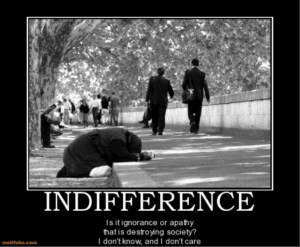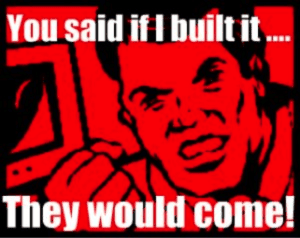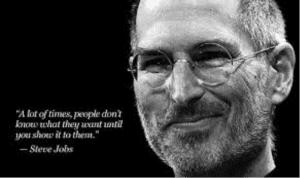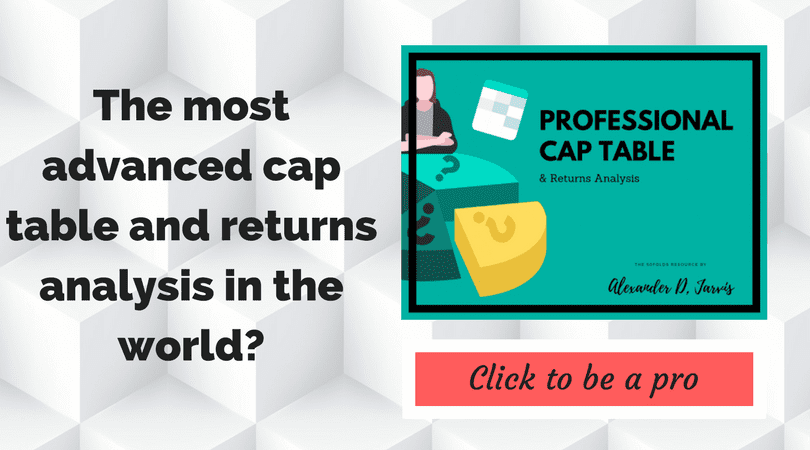TL;DR; A blog to explain why the business problem your startup is so important and how your solution needs to be an outcome to that problem
Harvard Business School marketing professor Theodore Levitt once said on problems,
“People don’t want to buy a quarter-inch drill. They want a quarter-inch hole!”
Founders spend too much time trying to create products with features rather than satisfying real needs and thinking about the ‘why’ they are doing what they are doing.
I spend a lot of time reviewing business models and talking to entrepreneurs, and one common theme I find with bad ideas and well, bad businesses, is that what they are doing is not actually solving a real business problem. In other words, the solution they offer is not a customer’s problem. Sometimes my problem with what they are doing is not that they are solving a problem, they might be but on too small a scale, but that it is a ‘feature’, it should be part of something else solving a bigger problem.
Reasons why founders don’t deliver solutions to a business problem, or solutions to their perceived problems
1. Lack of knowledge / Ignorance / Indifference
These are required for supernormal profits on the customer side, but not great traits in founders. Many people just don’t get users and what they really need.
They don’t have an Arrington scale knowledge of models to have a reference point to understand what worked and didn’t. They don’t read enough. More importantly, they don’t talk to customers. This is what Blank preaches with Customer Development Methodology.
At the extreme end, I chatted to an entrepreneurial hopeful at a Founders Institute event that wanted to copy Facebook, and I mean clone. The last thing we need is another Facebook, and seriously, you just aren’t going to win here buddy. The idea of even a niche network was a revelation. Read more, know your field. Then go understand the pain potential customers have and do something about it.
2. I built it so I am going to find a way to use it
Developers normally do this. They have an idea, they build and they don’t really get the concept of sunk cost. There must be an application for the 300 hours of work I put in is the rallying cry!
Unfortunately, a pig with a different shade of lipstick is still swine. With the time they spend trying to find a new, creative application, they could instead just build something awesome people actually want and need.
3. They see a business model and think I can do x for y
Good artists copy, real artists steal. There is something to this, but you have to understand that if you take a concept in one niche and apply it to another, there are fundamental differences you have to account for and adjust to. Blindly copying Square for the Philippines is dumb. Go look at how many people have bank accounts. Look into remittances instead, much bigger market and there are a lot of interesting startups in the area now, which have promise (One does plan on Square being a part of it actually).
4. They start looking for solutions, not business problems first
Great business ideas more often than not are organic. So many bad ideas are generated as founders begin by trying to think up startup ideas. The danger is that you look for ideas anywhere and not necessarily in just areas of your competence or expertise. So you don’t have deep knowledge and that makes you vulnerable. When you do find that spark of inspiration, you get so enamored by it that you get duped into going for it. It is this point that I am going to elaborate upon the most.
5. Damn it! Jobs said people don’t know what they want till you show them!
Firstly, you aren’t Jobs and secondly, you aren’t jobs. I am not saying there aren’t a 1,000 Jobs equivalents hiding around the globe, but there simply aren’t many people with the same vision and detailed understanding. I also imagine there was a lot of thinking behind why he put “1,000 songs in your pocket” before he built it.
Clayton Christensen from HBS said, “with few exceptions, every job people need or want to do has a social, a functional, and an emotional dimension. If marketers understand each of these dimensions, then they can design a product that’s precisely targeted to the job. In other words, the job, not the customer, is the fundamental unit of analysis for a marketer who hopes to develop products that customers will buy.”
So yes, in a sense you can not understand customers specifically, but you really have to understand the job the customer wants to accomplish, and that means talking to targeted customer demographics, and with the right questions. The point is to understand the underlying problem and need, not specifically the customer individually. There is a distinction.
Pain needs a name
To really solve a problem means you have to understand what the pain is, you have to define it, you need to give it a name. Call it Alice if you like, but you need to be friends with it. You need to understand why she is crying, or just a little upset. Knowing the name of something gives one power over that thing.
“God said ‘Let there be Light’ and there was light.”
Think about this. God named the ‘thing’ before he created it; naming is a necessary first step toward the creation or your solution.
The dragon you need to slay needs a name (Goliath, perhaps?). And as it is with pain and business problems, your solution will get a name too. The pharmaceutical industry spends a lot of cash branding their painkillers.
Fundamentally painkillers can be characterized into two boxes:
- Aspirin – need to have
- Vitamin – nice to have
You take vitamins when you get up in the morning in the hope they make you healthy, but if you forget to take them or are busy, you don’t really care. However when you have a headache, you are going to go looking for aspirin, you will stop what you are doing and go hunting for it. Aspirin is what you need. I learnt this from Dave McClure who is my favorite founder in terms of personality; I mean he is the only person who swears as much as I can.
Are you a disease or a symptom? Does your pain deserve a name?
In marketing, they say, “sell benefits not features”. Fine, this is good advice, but I have decided it applies to business models.
Customers need benefits not features. You should build features because they deliver benefits. At a greater level, you need a business model that provides a greater and holistic meaning composed of benefits.
How I define a ‘feature’ business:
- Unmemorable – you can’t remember the name 5 mins later and you don’t feel like searching to read about it
- No repeat use – bounce rates are high, repeat rates are near zero
- Delete the app from phone / not on the first page – I believe great apps are on your first screen page. Good are on the 2nd/3rd and bad ones get deleted fast
- Virality factor = 0 – you don’t tell any friends
- Unmonetisable – you aren’t willing to spend any cash. Your utility benefit < cash pain
Facebook’s meaning is making the world more connected, a benefit of this is stalking your old girlfriends in case you can get “made, paid or rather Laid”. The ability to “throw sheep” is a feature, not a greater benefit.
Your business must provide a clearly articulable benefit to users, not simply a feature, which is a supporting part of a benefit.
I have seen many businesses, which are basically features. When I say features what I mean it is something should be a little part of something else that already exists. Sure you are solving a problem, good for you, but you still aren’t going to win. You need users to be able to translate what you do into a something a user decides you do. It needs to provide meaning to them. If it doesn’t you are a feature.
You might say, hey Facebook bought a feature for their app! Facebook would buy a feature; to them, it is a feature. But to get noticed it wasn’t a feature, it was a standalone business with real benefit to a certain subset of customers (and probably a talented team).
In other words, does your pain deserve a name? You really want a vicious disease kind of pain. So in this analogy, your feature benefit is a symptom of something that should be bigger and have more meaning.
Pain felt by the many is better than the few, but it has to hurt a lot
Big markets are better than small ones. There is more cash to be made in a cure for Cancer than for PML. The more people who have a real pain point, the larger your Targetable Addressable Market (TAM).
A big TAM is important as it means:
- You can get investors, and
- You have a much better chance of getting lots of customers.
In my experience, it is almost as much work to launch a big business or expand to a big country as it is for a small one in both cases. Stick to big markets, you won’t get Laid if you are crying, normally.
But a lot of people in pain does not a sadist make. Those people need to be hurting, bad. Your pain deserves a name when it hurts (“Spank me harder!”). Do people really want the product or are they ambivalent to it? If people have a little tingle they are not going to run across the road to buy your aspirin.
I feel that whatever you do people should feel strongly about it one way or the other. A shrug and an ‘eh’ are not positive. ‘You are the spawn of Satan’ or ‘when can I get my hands on this’ are better responses. The later as it means people will buy it and the former is that people will talk about it, and it is better to be talked about than to not be talked about at all.
If you don’t have a huge market of people rolling over in pain, then a niche strategy can work for you. There are still plenty of billion dollar niches. Find a pain point with enough people hurting, and hurting bad.
The easiest way to know if you are solving a business problem is $$$
“It’s all about the Benjamin’s baby.” – The artist formerly known as Puff Daddy
Are people willing to dole out their hard earned green to pay you? I want to make an important difference here that many might not twig. Stated vs. actual is not the same.
In online dating, research has shown that people don’t know what they want. Specifically,
“people’s idiosyncratic stated preferences predict who appeals to them in a profile but not necessarily who appeals to them in person” (Finkel et al., 2012)
In other words, they say they want a blond bombshell and actually end up dating a brunette cutey. I would make a Sex in the City reference, but I don’t know the girls’ names.
The same thing applies when it comes to money. If you ask your best friend if he will pay you $20 for your widget, that is a start, but it doesn’t mean squat. Say, “awesome, just for you I will accept a cheque!” (If people still use those). If they get out the chequebook then you are gold, if not, you just learned that his migraine is not your aspirin, or she doesn’t really have a headache. “Not tonight hunny bun.”
Good solutions do one or more of three things
To make a gross simplification of what a great product will do for someone at a fundamental level is as follows. People want to get:
- Paid – Cash
- Made – Power
- Laid – Fornicate
This rhymes so there is no reason to forget about it. For some models, It can be hard to put them in a box. SurveyMonkey and MailChimp are getting Paid, but I doubt their users are getting Laid and Made much. The basic thing to take away here is you are gold if you get people made, paid or laid.
If you want to really understand human motivation, the sneaky art of cold reading has something to say. Kenton Knepper who wrote Completely Cold, says “understand that every human experience falls into a very few basic categories”:
- Health
- Wealth
- Relationships
Once you know these primal motivators you can understand everyone. You can fathom why your product will resonate and get traction. You are delivering that which provides meaning to people at their core.
The best products provide meaning and answer why
Simon Sinek talks about the golden circle,
“It provides insight on how to turn an idea into a social movement.”
Don’t you want to start a revolution, Tracy Chapman style? Don’t you want that emotional commitment?
Look at the image below with three circles. Companies like apple go from the inside out, HP goes inwards. If you start with why, you get to the what. Your solution is then truly their business problem. Everything you do is consistent, you know why you are doing what you are doing, and when customers buy from you they are buying the ‘meaning’, the ‘why’, they aren’t just buying the ‘what’, a ‘computer’. That’s how you get margins and brand loyalty.
Look at it this way:
- What are ‘features’ our product HAS and what ‘advantages’ our features DO: Our product ‘has a syndication feature’ which ‘provides real-time’
- How are the motives, what is satisfied: Our product is ‘more energy efficient and cost saving’
- Why provides meaning to features, the advantages are linked to the motives: we do beautiful things, anything we do would be beautiful, we just happen to have the most energy efficient syndication
To me, the absolute best businesses provide meaning, but the meaning translates something different to each user. The brand resonates with people and is like poetry, it is open to interpretation. A lot of this becomes due to the narrative that companies build, that allows people to create their own reasons for buying from a company, their own meaning.
A great example to me is Warby Parker. They basically sell Chinese glasses for $95, but everything about the brand communicates meaning to their customers. To one person, they sell glasses that look good to help people get laid, to another they love the TOM’s Shoes BOGO rip off and the sense that their consumerism has meaning. It is a great brand, customers have the ammo to write their own personal relationship to the brand they want to tell their friends about.
Learn to identify problems, start with yours
All too often people grumble and complain about something, oblivious to the notion that that problem can really be your next startup idea and really SHOULD!
Are you solving a problem that you have? If for no other reason, you know the problem really exists for you? So long as your problem and yourself aren’t at the extremities of the normality bell curve, you will be making at least more than one person happy. One is a good start.
Fortune favors the prepared mind. So to identify a problem that really needs to be solved you need two things:
- an event or stimuli, your spark of inspiration, and
- a mind prepared to register that input as something that needs an opportunity.
Getting your head ‘switched on’ to start seeing problems is a matter of mindset and something you have to train yourself to do. The great thing is that you really can! I know because I did. Let’s face it, we were all born knowing nothing. This is why I don’t believe there is such thing as a stupid question (Unless if you ask me and I can reply with lmgtfy.com).
A massive learning for me as a child was from my uncle, my first role model, who was a banker (Hence why I was the only 10-year old that wanted to be in M&A and why I was). I asked him how he knows so much. He replied
“In any meeting, no matter who was in the room, if I didn’t understand something, I would ask why. After I did, I knew the answer. I kept asking questions every day and was never afraid to look silly.”
Tony Robbins talked about ‘green cars’. When you want to buy a green car you start seeing them everywhere. The same thing goes for opportunities, when you are looking for them, you start to see them everywhere. This is just the first part, you then need to develop a filter to sort between the good and bad ideas. There is no simple solution to success here, it requires a lot of elbow grease. You have to read a lot and start to understand dynamics, customers attitudes, the technical landscape, your ability to execute it, the marketing costs to acquire customers etc.
Simply put, once you have identified a real problem, there is a lot of work to do. You know you have figured out a great solution when after an immense amount of work, in boiling that idea down to something you can explain in a sentence that someone will say ‘uh, isn’t that obvious!’ Ha, it’s obvious now, but it sure as hell wasn’t obvious before.
‘One click shopping’ is a great example of this. It seems obvious now, but it sure as hell wasn’t before. Bezos had to continually berate the devs to go back to the drawing board to not do 3-click shopping but ONE click shopping!
Ideas come when you least expect, be prepared for them. You can encourage them though
This all starts to sound like a process that is certain, but it is not. Time does not work to your schedule here, inspiration can come at any time. You can, however, help ideas to come to you when you are ready to receive them.
Prepared means you are continually searching. You hear a stimulus and your brain immediately starts ticking over, looking for a connection. Seeing if you have an angle. You wonder if this a business problem you have and relate to. Is this something you sister has, is this something all your sister’s friends would have too? What are the margins like, how much can your charge. Who is working on this already, how are they doing? Are they doing a good job and if not, how can you do better? As you get better at doing this you will quickly start filtering what is worth looking into and what is a waste of time, and why.
I have found that the number of people I talk to is directly correlated to the number of potential great ideas I happen upon. You meet someone with a completely different background and mentality and they say something that sparks an idea in your head. Sometimes the ideas are simply presented to you. I have had friends say ‘you should talk to John, he is looking to do something interesting, maybe you can help him?’ That is now crowdsourcing inspiration and is incredibly effective. Again, you can’t plan for this; it’s like playing roulette. The odds aren’t high, but if you can keep spinning the wheel your odds of eventually winning (not your odds) go up, you will eventually win. Get out and talk to people, but be paying attention.
Let me tell you two things, something about me and a secret which I use to start thinking as soon as someone starts talking about a business problem and leads people to think I am good at math.
- I got crappy grades in school at math, I know why but let’s not get into it (About applicability of teachings and so my interest). But I can model the shit out of excel and love logic. I once, for fun, built a model to forecast the value of a life insurance company on an MCEV basis with nothing other than an annual report, broker reports and a pen and paper to do algebra. I learned to deconstruct business problems and how things interact. I use this mentality everytime we talk about something.
- As you are talking I am already doing math in my head, preempting possible questions. The second you finish a sentence alluding to, whatever, “how many hours there are in a work week in Indonesia” after asking how many there are in a day, I already thought of the week question. I was already answering it which is why I answer fast. It’s not that I am special at math, it is just that I am thinking ahead, thinking things through
This is not some Zen wish wash, I am simply saying, be switched on all the time and be paying attention, be thinking. It is a prepared mind.
* James Altucher said every presentation needs a pretty girl
Don’t expect people to get your ideas though, all the time
Not everyone has the business problem you are trying to solve, maybe they don’t have it, but the person across the room might though. Not everyone can dream how their life can become easier or better with it until they are actually using it (See above re: Jobs) . So don’t get discouraged talking to people. You are meant to be the visionary here.
If this sounds conflicting to some of what I am saying about really knowing customer pain and the customer, that’s because it is if you have not being paying attention. You are asking the wrong questions, as I said, you are asking about the person and not the ‘job’ they are trying to accomplish. When you start asking people about themselves and the ‘job’, they are not really going to get you. It is data to them, it is your job to turn those multiple data points into instructive, actionable information.
New solutions happen not following tracks in the snow, they materialize in the future where your solution to a business problem does not exist. You therefore have to understand that people have a business problem, even if the customer does not always understand it… right now. That’s your job, to ship a solution and get them to start using it and see it for themselves.
There are exceptions to every rule and Twitter is a good example of this. They saw there was a gap, in that no one could communicate what someone was doing right now, this was the idea of Jack Dorsay. Another co-founder that doesn’t get much recognition is Noah Glass, that saw that this instantaneous, short-form communication could help people to rapidly see news as it unfolded. Was there an exact business problem being solved? Arguably not. At best they saw a fuzzy gap in the market. What they did was to go and just build it and see if it resonated with customers.
That’s what customer development methodology is about. See business problem and a gap, rapidly prototype and see if you get product market fit. If not pivot and respond to customer feedback. Start with a stated hypothesis of what business problem you are trying to solve and the benefits, through the features you are making, that meet a need of your targeted customers. If it is not hitting, then respond to what is useful, what is solving a problem and test a new hypothesis. Eventually you will hit upon something. Remember you are technically out ‘talking to people’ now; just this time they are real customers who are already engaging with your product.
Timing matters, competitors don’t
Timing as they say, is everything. Take NFC, it can solve a real problem and people tried a few years back and the timing sucked. I have a friend who tried, so I know this. He simply said “The timing was off, the market wasn’t ready.” Companies are trying again but the landscape has changed, the tech is not relevant (Let’s see but likely BLE will likely fare better).
Competition does not matter as much as you think. Look at Rocket Internet, their whole MO is finding good ideas working and getting traction, cloning and making it more successful in other markets. Sure they have great people and a lot of cash, but this doesn’t matter. You can do it too.
The great thing about copying is that you already have product / market fit. Ideally you came to the idea yourself, by seeing and feeling the business problem yourself. After 5 minutes on Google or on TechCrunch you see someone doing something similar. You now also have validation. You can see if it is working and traction they are getting. You can see what they do well and what they do poorly. It is so much easier to critique something that exists than to start with a clean sheet of paper.
So see what the competitors are doing and understand what they are missing and how your idea is going to do it better and differently. Look at Google, who needed just another search engine? Google did the same concept that was being done already and just did it way better and differently. When they entered the market it was relatively crowded, but that simply gave validation to the idea that there was a defined need. The fact the market was fragmented was a positive! Why? Because if someone was doing a great job, there would likely be less people or at least there would be far higher market share concentration in the number one spot and top 3-5 spots.
Competition is good, not bad. You should be more worried if there are not competitors at all, because you aren’t as special as you would like to think. Somewhere around the world there are 20 people with the same crappy idea you just had, they may have even tried. There isn’t really that much new under the sun. The business problem is if those 20 people haven’t succeeded then either they failed or they found out that the idea doesn’t work. Better they tried before you and got traction. Learning from others’ failures is awesome. At the end of the day, execution is what really makes a difference.
Also, big markets are best, and there are only so many big markets. Someone somewhere is targeting that big market. It is much better to be in a big market with some successful companies than to be in a big market with failing competitors, assuming moderate capabilities of execution.
Don’t be deterred by competition. They have also spent money educating the market for you. It is a hell of a lot easier to say in a sales pitch “you heard of Groupon, yeah? Well, we are the same but better and just for France” than having to educate people from scratch. I have used this sort of tactic in every startup I have worked in. We found through experience that when we were in a market where the prospects knew or had used a competitor the sales was easier. We would simply say, “You heard of X? We do the same thing, but let me tell you why we are better!” Man did we save time with those prospects, and it helped us get to market leaders in 6 months every time.
Conclusion
If you want to have a successful business you need paying customers. You get people to pay when they are hurting. Your idea stems from that specific pain and not in blindly looking for a solution and then seeing if it ticks some sort of pain box. Learn about that pain, name it and relate to it. Create a meaning around that pain that ameliorates it through communicable benefits with a narrative people can tell themselves and their friends. Your features are merely a function of those benefits. Talk to people and learn from them, then give them the opportunity to really experience it so you can learn how they interact with it, and maybe if it stops their head from pounding they will pay you money and ultimately, you won’t be wasting your time on a bad idea.
Their business problem will be your solution.

























Comments 2
Hi Alex, I met you a few years ago in a Singapore Switch Dinner or something. Have enjoyed your articles, tools and bluntness of it all.
All the best!
Best Regards
CL
Author
Hey CL- Thanks for the kind words.
Have been away from SEA for so long! Looking forward to being back at some point.
Hope things are going well for you!
Alex